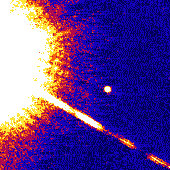|
COMETS EARTH JUPITER KUIPER BELT MARS MERCURY METEORITES NEPTUNE OORT CLOUD PLUTO SATURN SOLAR SYSTEM SPACE SUN URANUS VENUS ORDER PRINTS
PHOTO CATEGORIES SCIENCEVIEWS AMERICAN INDIAN AMPHIBIANS BIRDS BUGS FINE ART FOSSILS THE ISLANDS HISTORICAL PHOTOS MAMMALS OTHER PARKS PLANTS RELIGIOUS REPTILES SCIENCEVIEWS PRINTS
|
Related Documents
Download Options
This false-color Hubble telescope image reveals the faintest object ever seen around a star beyond our Sun, and the first unambiguous detection of a brown dwarf. The brown dwarf, called GL229B, orbits the red dwarf star Gliese 229, located approximately 18 light-years away in the constellation Lepus. The brown dwarf is about 20-50 times the mass of Jupiter, but is so dense it is about the same diameter as Jupiter (80,000 miles). Brown dwarfs are a mysterious class of long-sought objects that form the same way stars do, by condensing out of a cloud of hydrogen gas. However, they do not accumulate enough mass to sustain nuclear fusion at their core, which make stars shine. This image of the GL229B (center) was taken with Hubble Space Telescope's Wide Field Planetary Camera-2, in far red light, on November 17, 1995. The Hubble observations will be used to accurately measure the brown dwarf's distance from Earth, and yield preliminary data on its orbital period, which may eventually offer clues to the dwarf's origin. Though the star Gliese 229 is off the edge of the image, it is so bright it floods Hubble detector. The diagonal line is a diffraction spike produced by the telescope's optical system. Credit: S. Kulkarni (Caltech), D.Golimowski (JHU) and NASA |
